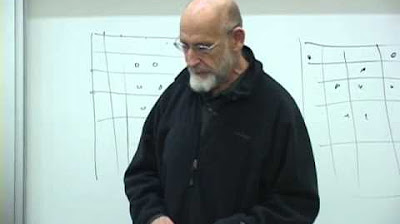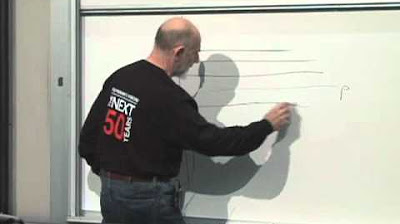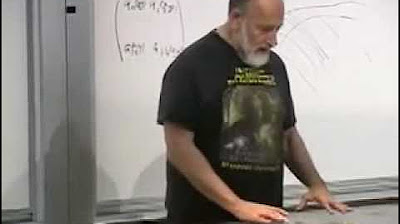General Relativity Lecture 5
TLDRThe video script delves into the intricacies of spacetime and the principles of general relativity, focusing on the Schwarzschild metric which describes the gravitational field outside a spherical, non-rotating mass. It explores the concept of proper time and how it is minimized in the path of a particle moving in a gravitational field, leading to the derivation of geodesic equations. The lecturer discusses the transformation of the metric under Lorentz transformations and the importance of maintaining the signature of the metric, which reflects the fundamental distinction between time and space. The script also touches on the behavior of light rays in the context of the Schwarzschild metric, particularly as they approach the event horizon of a black hole, where peculiar effects such as time dilation and the slowing of light are observed. The discussion is rich with mathematical insights and thought-provoking questions about the nature of spacetime, the limitations of our current understanding, and the potential for unifying gravity with other fundamental forces through higher-dimensional theories.
Takeaways
- 📏 The concept of spacetime and its relation to special relativity is fundamental, with the metric used to describe intervals in spacetime being crucial.
- 🌌 Special relativity introduces the idea of proper time (∆s), which is the time experienced by an observer in motion and is related to the spacetime interval.
- 🚀 The speed of light (c) is a constant that helps in differentiating between relativistic and non-relativistic limits, with significant implications for the behavior of time and space.
- ⏳ Time-like, space-like, and light-like vectors are classifications based on the sign of the spacetime interval and describe whether an event is within, outside, or on the boundary of the light cone.
- 🧮 The metric tensor is a key component in general relativity, describing the geometry of spacetime and having a signature of (-,+,+,+), which is vital for maintaining the distinction between time and space.
- 🌟 The Schwarzschild metric is used to describe the spacetime geometry outside a spherically symmetric, non-rotating mass like a black hole or a star.
- ⚫️ At the Schwarzschild radius (R = 2GM/c²), there's a coordinate singularity, where the concept of time and radius interchange, but this is more of a coordinate effect rather than a physical one.
- ⏳ An object falling into a black hole will appear to an external observer to slow down and never cross the event horizon, while an observer falling with the object would experience no unusual effects at the horizon.
- 🌌 The non-relativistic limit allows for the approximation of the metric, which can be used to derive Newtonian gravity from general relativity in the appropriate limit.
- 🔍 The behavior of light rays near the event horizon is such that their radial velocity goes to zero, meaning not even light can escape from within the event horizon.
- 🤔 The unification of gravity with other fundamental forces is a topic of ongoing research, with theories suggesting additional dimensions where gravity becomes a part of a more complex geometric framework.
Q & A
What is special relativity?
-Special relativity is a theory in physics that deals with the behavior of objects moving at high speeds, close to the speed of light. It introduces the concept of spacetime and the idea that the laws of physics are the same for all non-accelerating observers, and it revolutionized our understanding of time, distance, and simultaneity.
What does the term 'metric' refer to in the context of special relativity?
-In the context of special relativity, a 'metric' is a mathematical construct that allows us to define the spacetime interval, which is a measure of the distance between two points in spacetime. The metric used in special relativity is often represented by the Minkowski spacetime, which is flat and incorporates the speed of light to describe the relationship between space and time.
What is the significance of the speed of light in special relativity?
-The speed of light is a fundamental constant in special relativity. It is the maximum speed at which information or matter can travel, according to the theory. The speed of light plays a crucial role in determining the spacetime interval and the transformations between different inertial frames of reference.
What is the concept of a light cone in special relativity?
-A light cone in special relativity is a graphical representation that illustrates the paths that light can take from a single event in spacetime. It is a way to visualize the causal structure of spacetime. The light cone divides spacetime into regions where events can or cannot influence each other.
What does it mean for a spacetime interval to be timelike?
-A spacetime interval is considered timelike if the square of the time separation (dt^2) is greater than the square of the spatial separation ((dx^2 + dy^2 + dz^2)/c^2). This means that the interval is predominantly temporal, and events within a timelike interval cannot be causally connected by light.
What is a spacelike interval and how does it differ from a timelike interval?
-A spacelike interval occurs when the square of the spatial separation is greater than the square of the time separation (dt^2), represented as (dx^2 + dy^2 + dz^2)/c^2 being greater than dt^2. This indicates that the interval is predominantly spatial, and events within a spacelike interval are causally disconnected, meaning no information can travel between them faster than light.
What are the different types of vectors in the context of special relativity?
-In the context of special relativity, there are three types of vectors: timelike, spacelike, and lightlike. Timelike vectors have a time component greater than the spatial components, spacelike vectors have a negative spacetime interval, and lightlike vectors lie on the light cone and have a spacetime interval of zero.
What is the Schwarzschild metric and why is it significant?
-The Schwarzschild metric is a solution to Einstein's field equations of general relativity that describes the spacetime geometry outside a spherically symmetric, non-rotating mass like a star or a black hole. It is significant because it provides a model for understanding the effects of gravity on spacetime, particularly in the context of black holes.
What is the concept of proper time and how is it used in special relativity?
-Proper time is the time measured by a clock moving along a specific worldline in spacetime. It is the time interval between two events as measured by an observer who is at rest relative to the clock. In special relativity, proper time is used to describe the elapsed time for an object in motion, and it is invariant, meaning it is the same for all observers regardless of their relative motion.
How does the Schwarzschild radius relate to the concept of a black hole?
-The Schwarzschild radius is the distance from the center of a mass at which the escape velocity equals the speed of light. If a mass is compressed to a size smaller than its Schwarzschild radius, not even light can escape from it, and a black hole is formed. The Schwarzschild radius is directly proportional to the mass of the object.
What is the significance of the event horizon in the context of a black hole?
-The event horizon is the boundary around a black hole beyond which nothing, including light, can escape the black hole's gravitational pull. It is significant because it defines the point of no return for any object approaching the black hole. Once an object crosses the event horizon, it is inevitably drawn into the black hole.
Outlines
📚 Introduction to Special Relativity and Metrics
The paragraph introduces the concept of special relativity, focusing on the metric used to calculate proper time. It explains the significance of the speed of light in the metric and how it helps in understanding the relativistic effects. The difference between time-like, space-like, and light-like vectors is discussed, along with the concept of the light cone and its boundaries.
🌌 The Physics of a Single Time Direction
This section delves into the physics principle that there's always one time direction and three space directions in our universe. It discusses the implications of having multiple time directions and the structure of the metric tensor, emphasizing the invariant nature of the space-time metric and its role in defining the geometry of space-time.
🔄 Transformation and the Light Cone's Variability
The paragraph explores how the light cone's appearance can change due to coordinate transformations, emphasizing that these changes do not reflect a real alteration in geometry. It also touches on how the speed of light could vary by position, affecting the metric's appearance.
🚀 The Geodesic Principle and Action Minimization
This section introduces the principle of geodesics as the shortest or stationary distance between two points in space. It connects this principle to the concept of action in physics, explaining how the Euler-Lagrange equations can be used to find geodesics by minimizing the action.
🧮 The Calculation of Proper Time and the Role of Mass
The paragraph discusses the calculation of proper time between two space-time points and how it differs from coordinate time. It explains the role of mass in the action, and how the action is minimized for a particle moving on a trajectory, leading to the concept that the mass term is crucial for understanding energy in the context of general relativity.
🪐 The Motion of Particles in a Gravitational Field
This section focuses on the motion of particles in a real gravitational field, such as that of the Sun, Earth, or a black hole. It introduces the concept of the Schwarzschild metric as a model for the space-time metric outside a massive, spherically symmetric object, and discusses how this metric can be derived from the principles of general relativity.
🌟 The Schwarzschild Metric and its Coordinate Singularities
The paragraph examines the Schwarzschild metric in more detail, highlighting the coordinate singularity at the Schwarzschild radius and discussing the physical implications of this feature. It also touches on the concept of the event horizon and how the metric describes the space-time geometry in the vicinity of a black hole.
📏 Polar Coordinates and the Schwarzschild Metric
This section introduces the use of polar coordinates to express the Schwarzschild metric, which is particularly useful for studying central force problems like gravitational fields. It explains how the metric components change when expressed in these coordinates and what this implies for the geometry of space-time.
🔍 The Behavior of Light and Particles Near the Event Horizon
The paragraph investigates the behavior of light and particles near the event horizon of a black hole. It explains that even light cannot escape once it crosses the event horizon, as observed from an external perspective. The discussion also touches on the concept of time dilation and the slowing down of time near the horizon.
🤔 Questions and Insights on Black Hole Growth and the Speed of Light
This section addresses questions about the growth of black holes and the behavior of the speed of light in the context of general relativity. It clarifies misconceptions about black holes never forming or growing and discusses the constancy of the speed of light from different reference frames.
🔬 Unifying Gravity with Other Forces and the Nature of Space-Time
The final paragraph explores the concept of unifying gravity with other fundamental forces, possibly through the addition of extra dimensions. It discusses how such unification attempts might work and the implications for our understanding of space-time and its signature in the context of general relativity and potential quantum corrections.
Mindmap
Keywords
💡Special Relativity
💡Metric
💡Proper Time
💡Light Cone
💡Space-like and Time-like Intervals
💡Gravitational Potential
💡Schwarzschild Metric
💡Event Horizon
💡Geodesic
💡Lorentz Transformation
💡Action and Lagrangian
Highlights
Special relativity is discussed in the context of a metric called proper time, denoted as \( D^2 \), which is a combination of space and time intervals.
The speed of light is incorporated into the metric to study different limits, such as the nonrelativistic limit where velocities are much smaller than the speed of light.
The concept of time-like and space-like intervals is introduced, with time-like intervals having a greater time component relative to the space components.
Light-like vectors are defined as those for which \( D^2 \) equals the spatial part of the metric, representing the path of light rays.
The number of time and space directions is a fundamental aspect of the metric tensor, with physics only considering one time direction and three space directions.
The metric tensor is described by a matrix that has one negative eigenvalue and three positive eigenvalues, reflecting the spacetime structure.
The Schwarzschild metric is introduced as a solution for the metric of spacetime surrounding a massive spherically symmetric object like a black hole.
The concept of geodesics is explained as the shortest path between two points in spacetime, which particles follow in a gravitational field.
The action for a particle in a gravitational field is defined, and its minimization leads to the equations of motion for the particle.
The non-relativistic limit of the action leads to Newton's equations for a particle moving in a gravitational potential.
The Schwarzschild radius is identified as a critical value, where the metric components change sign, indicating a transition from spacelike to timelike behavior.
The behavior of light rays near the event horizon of a black hole is analyzed, showing that even light cannot escape once it reaches the Schwarzschild radius.
The concept of proper time is contrasted with coordinate time, with the former being the time experienced by an observer within a falling object.
The talk explores the implications of the Schwarzschild metric for the behavior of particles and light in the strong gravitational field near a black hole.
The issue of unifying gravity with other forces is touched upon, with the suggestion that extra dimensions may provide a framework for such a unification.
The signature of the metric in general relativity is discussed, highlighting the resistance of the theory to changes in the number of time and space dimensions.
The historical context of Schwarzschild's work during World War I is mentioned, emphasizing the complexity of his mathematical achievements under challenging circumstances.
Transcripts
5.0 / 5 (0 votes)
Thanks for rating:





